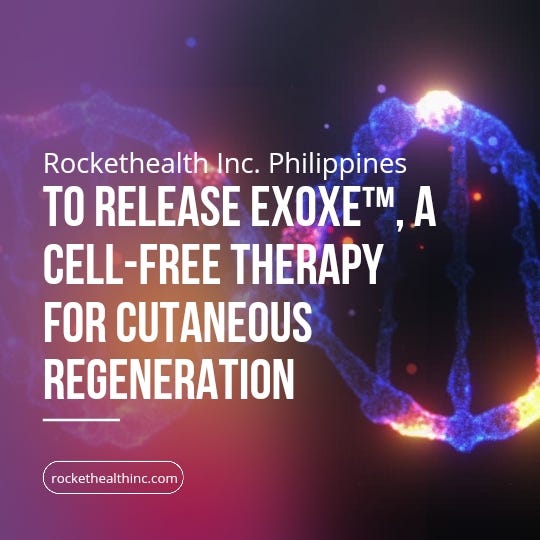Lunchtime Read: The Healing Revolution - Unlocking the Potential of Human Amniotic Fluid Stem Cell-Derived Exosomes in Wound Care
The largest organ in the body, the skin, serves as your first-line defense against aging. We now have new technologies, called exosomes, to rejuvenate our skin.
In the ever-evolving field of regenerative medicine, the search for innovative and effective therapies is a constant endeavor. The study of human amniotic fluid stem cell-derived exosomes (hAFSC-Exos) has emerged as a promising frontier, offering a novel cell-free therapy for cutaneous regeneration. This article delves into the introduction and background of this exciting area of research, unraveling the potential of hAFSC-Exos in wound healing.
The Wound Healing Challenge
Wound healing is a complex and multifaceted process that involves a series of coordinated events, including inflammation, tissue formation, and remodeling. Chronic wounds, such as diabetic ulcers and pressure sores, pose a significant challenge to healthcare systems worldwide. The failure of conventional treatments to effectively address these wounds has led to a growing interest in alternative therapies.
The Promise of Stem Cells
Stem cells have long been recognized for their regenerative potential. Their ability to differentiate into various cell types makes them a valuable tool in tissue repair and regeneration. Human amniotic fluid stem cells (hAFSCs), in particular, have shown promise in various therapeutic applications, including neurological disorders, liver diseases, and bone regeneration.
Exosomes: The New Frontier
Exosomes are small vesicles secreted by cells that play a crucial role in intercellular communication. They contain proteins, lipids, and nucleic acids that can influence the behavior of recipient cells. The study of exosomes derived from hAFSCs has opened up new avenues for therapeutic interventions, particularly in the field of cutaneous regeneration.
hAFSC-Exos in Cutaneous Regeneration
Cutaneous regeneration refers to the restoration of skin tissue following injury or disease. The application of hAFSC-Exos in this context has shown promising results in preclinical studies. These exosomes promote wound healing by modulating various cellular processes, such as proliferation, migration, and differentiation.
The therapeutic potential of hAFSC-Exos lies in their ability to enhance angiogenesis (formation of new blood vessels), reduce inflammation, and promote collagen synthesis. These multifaceted effects contribute to the overall improvement in wound healing, making hAFSC-Exos an attractive option for cell-free therapy.
Specific MicroRNAs (miRNAs) Derived from Human Amniotic Fluid Stem Cell-Derived Exosomes (hAFSC-Exos) in Wound Healing
Human amniotic fluid stem cell-derived exosomes (hAFSC-Exos) have been identified as a promising therapeutic approach for wound healing. The specific molecules within hAFSC-Exos that contribute to this process include several microRNAs (miRNAs), paracrine factors, and growth factors. We will enumerate and discuss these molecules and their contributions to wound healing.
1. Specific miRNAs Derived from hAFSC-Exos
Several specific miRNAs derived from hAFSC-Exos have been identified, including let-7-5p, miR-22-3p, miR-27a-3p, miR-21-5p, and miR-23a-3p.
1.1 Contribution to Wound Healing
These miRNAs directly target Transforming Growth Factor-beta Receptors (TGF-bRs), which play a crucial role in wound healing.
- let-7-5p, miR-22-3p, miR-27a-3p, and miR-23a-3p: These miRNAs inhibit fibrotic diseases by targeting TGF-bRs. They reduce fibroblast differentiation into myofibroblasts, thus suppressing fibrotic scarring.
- miR-21-5p: This miRNA inhibits TGF-bR2 in the regulation of myofibroblast differentiation. Its function may vary according to the state of the cell and the particular molecular network involved.
2. Paracrine Factors of hAFSCs
The paracrine factors of hAFSCs stimulate cell proliferation and migration and modulate redox imbalance.
2.1 Contribution to Wound Healing
- Stimulation of Cell Proliferation and Migration: These factors enhance the repair and regeneration of damaged tissue.
- Modulation of Redox Imbalance: These factors support the overall healing process by positively modulating redox unbalance.
3. Growth Factors and Tissue Regeneration Factors
The exosomal "cargo" may include various growth factors and tissue regeneration factors.
3.1 Contribution to Wound Healing
- Promotion of Tissue Regeneration: These factors contribute to the regeneration of skin tissue, including the restoration of hair follicles, nerves, and vessels. They also improve the natural distribution of collagen fibers and inhibit myofibroblast aggregation.
The molecules derived from hAFSC-Exos play a multifaceted role in promoting wound healing. They enhance cell proliferation, migration, and angiogenesis, reduce inflammation, and modulate various signaling pathways involved in regeneration. These findings underscore the potential of hAFSC-Exos as a novel therapeutic approach for wound healing and offer a promising avenue for future research and clinical applications.
The Road Ahead
The exploration of hAFSC-Exos as a novel cell-free therapy for cutaneous regeneration is still in its infancy. While preclinical studies have demonstrated promising results, further research is needed to fully understand the underlying mechanisms and optimize the therapeutic potential of these exosomes.
Clinical trials are essential to validate the safety and efficacy of hAFSC-Exos in human subjects. The development of standardized protocols for exosome isolation, characterization, and administration will be crucial in translating this innovative therapy from bench to bedside.
Conclusion
The study of human amniotic fluid stem cell-derived exosomes represents a cutting-edge approach to wound healing. By harnessing the power of these tiny vesicles, researchers are paving the way for a new era of regenerative medicine. The potential of hAFSC-Exos to revolutionize the treatment of chronic wounds offers hope to millions of patients worldwide, and the journey has only just begun.
In a world where conventional treatments often fall short, the innovative use of hAFSC-Exos provides a glimpse into the future of medicine. The road ahead is filled with challenges and opportunities, but the promise of healing wounds with a splash of science is a journey worth embarking on.
If you are interested to find out more, come visit us at rockethealthinc.com for more information.



